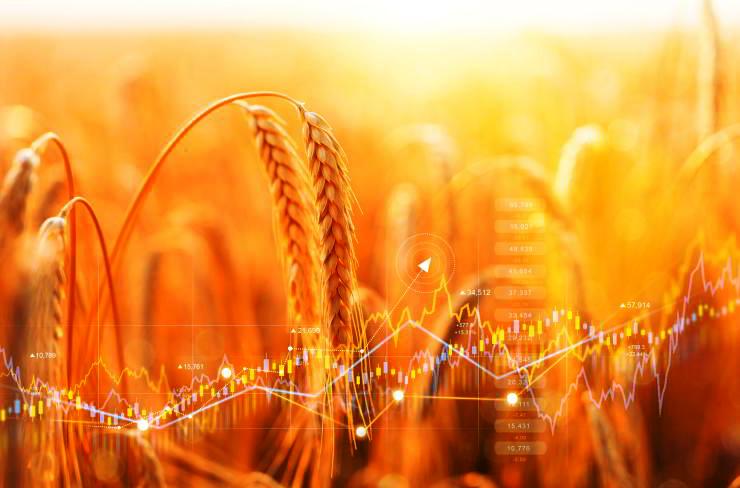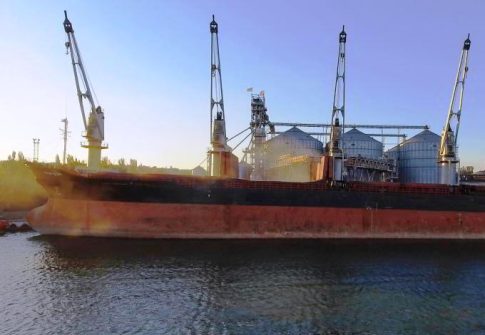The wheat market.

The price of wheat on the entire global market, like that of other cereals, has always been very low, undergoing little change
over the decades.
For the 2024 harvest, the prices of bread-making soft wheat stood at around €225/t, thus falling to a level around 8% lower than in 2023, when the product was traded at around €280/t, while those of durum wheat, again for the 2024 harvest, stood at around €300/t. According to estimates by financial analysts, the durum wheat market is set to record a constant increase in the coming years, and in particular in the decade 2020 – 2030. This is due to numerous factors including the development of the taste for pasta among a large world population and the demographic growth of African countries.

Cargo crane, ship and grain dryer in Port Odessa, Ukraine. Ukrainian exports were filled in 2023 by Russian exports. 123rf
The price of wheat, both soft and durum, depends fundamentally on three basic factors: the quantity of product available; the following year’s sowing forecasts and the quality of the wheat. To these are then added the variables determined by meteorological aspects, the volatility of financial markets, the price of hydrocarbons and phosphates, and geopolitical dynamics. Consider in this regard that in 2021 the disproportionate increase in temperature in Canada and the USA caused production to plummet (especially of durum wheat), influencing price increases in the autumn period, while in 2022, the effects produced by the Russian-Ukrainian war considerably upset the market, unsettling the balance at a global level.
If we look closely, in fact, the two countries involved in the war together represent 30% of world exports, and specifically Russia accounts for 18% and Ukraine for 11%. During the war, in fact, wheat was used as an element of geopolitical pressure, entering the sights of the belligerents. The Russians, in particular, have hit farms and cultivated fields, but also product storage centres, processing plants and transport infrastructure.

Egypt. Fayoume City. Making bread. Bread is a staple food in the Egyptian diet. Egypt imports 85% of its grain from Russia. © FAO/Ami Vitale
Furthermore, the consequent closure of ports in the Black Sea area by Moscow has led to the blocking of grain exports from countries not directly involved in the conflict, such as Kazakhstan, whose product is of excellent quality, but also the disruption of import markets and in particular those of the North African strip such as Tunisia which before the conflict depended on Ukraine for about half of its wheat supplies, importing about 47%.
In addition to Tunisia, there is Egypt where 85% of grain imports come from Russia (52%) and Ukraine (33%). Also, 75% of the cereals imported by Libya come from Ukraine and Russia, while Morocco imports 21% of its grain needs from Ukraine. Then there are countries that are totally dependent on grain imports from Ukraine and Russia like Eritrea, or nearly so like Somalia which is 90% dependent.
The void created by Ukrainian exports was filled in 2023 by Russian exports. In the same period, Russia also increased wheat exports to the regions of sub-Saharan Africa, also in order to use this resource as a soft power tool, to magnify its presence and extend its influence.
In the opinion of some analysts, even the July 2022 agreement for the export of wheat produced on the Black Sea coast, essentially Ukrainian wheat, mediated by the Turkish government, would have had the purpose of maintaining in African and Middle Eastern countries, largely dependent on Ukrainian wheat imports like Lebanon and Ethiopia
at 70% and 60% respectively, that attraction that they feel towards
the Russian Federation.

Loading of grain on a ship. 123rf
This closeness on the part of these countries had, a few months earlier, also been expressed within the General Assembly of the United Nations by their siding with Moscow in the vote that condemned the invasion of Ukraine. Therefore, in the opinion of analysts, the need to avoid the possibility that the lack of access to wheat by these countries could induce Ukraine and the Western allies to discredit the Russian Federation in their own eyes and those of the entire “global South” that represents the vast majority of humanity, has caused Putin to contravene the cruel rules imposed by war, which provide for the strangulation of the enemy also through the use of food resources, allowing their export.
The impact of the war on the sector and the relative change in global trade flows has also caused significant upheavals within the European market, resulting in tensions in the first months of 2024 as farmers took to the streets with their tractors in protest. (Open Photo: Rising wheat prices due to the conflict between Russia and Ukraine. Shutterstock/Miha Creative)
F.R.



